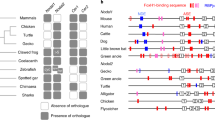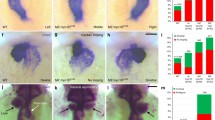A similar mechanism may underlie the handedness seen in all vertebrate body plans.
Abstract
How left–right handedness originates in the body plan of the developing vertebrate embryo is a subject of considerable debate1,2. In mice, a left–right bias is thought to arise from a directional extracellular flow (nodal flow) that is generated by dynein-dependent rotation of monocilia on the ventral surface of the embryonic node3,4. Here we show that the existence of node monocilia and the expression of a dynein gene that is implicated in ciliary function are conserved across a wide range of vertebrate classes, indicating that a similar ciliary mechanism may underlie the establishment of handedness in all vertebrates.

Similar content being viewed by others
References
Capdevila, J. et al. Cell 101, 9–21 (2000).
Wright, C. V. E. Dev. Cell 1, 179–186 (2001).
Nonaka, S. et al. Cell 95, 829–837 (1998).
Okada, Y. et al. Mol. Cell 4, 459–468 (1999).
Supp, D. M. et al. Nature 389, 963–966 (1997).
Supp, D. M. et al. Development 126, 5495–5504 (1999).
Olbrich, H. et al. Nature Genet. 30, 143–144 (2002).
Männer, J. Anat. Embryol. 203, 481–490 (2001).
Cooper, M. S. & D'Amico, L. A. Dev. Biol. 180, 184–198 (1996).
Author information
Authors and Affiliations
Corresponding author
Ethics declarations
Competing interests
The authors declare no competing financial interests.
Rights and permissions
About this article
Cite this article
Essner, J., Vogan, K., Wagner, M. et al. Conserved function for embryonic nodal cilia. Nature 418, 37–38 (2002). https://doi.org/10.1038/418037a
Issue Date:
DOI: https://doi.org/10.1038/418037a
- Springer Nature Limited
This article is cited by
-
Bioinspired magnetic cilia: from materials to applications
Microsystems & Nanoengineering (2023)
-
Exome sequencing of families from Ghana reveals known and candidate hearing impairment genes
Communications Biology (2022)
-
Motile ciliopathies
Nature Reviews Disease Primers (2020)
-
Functional analysis of new human Bardet-Biedl syndrome loci specific variants in the zebrafish model
Scientific Reports (2019)
-
An Interspecies Heart-to-Heart: Using Xenopus to Uncover the Genetic Basis of Congenital Heart Disease
Current Pathobiology Reports (2017)





